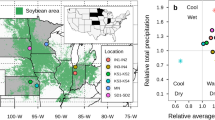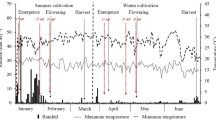Abstract
The sub-tropical legume, soybean [Glycine max (L.) Merr.], has lower grain yields at low temperatures, mainly due to reduced nitrogen fixation. The isoflavone genistein has been identified as one of the major compounds in soybean seed and root extracts responsible for inducing the expression of the B. japonicum nod genes. A 2-year field study was conducted in 1997 and 1998 with 11 soybean cultivars recommended for Québec, and representing a range of yield potentials and maturity groups. The objective of this study was to assess the variability among soybean cultivar maturity groups in terms of response to genistein application under Canadian short season and cool-spring conditions. The experiments were organized in a randomized complete block design with three replications. The two genistein treatments included B. japonicum inoculant pre-incubated with 20 μm genistein and B. japonicum inoculant only. The inoculants were applied into the furrow at the time of planting. The results of this study showed that genistein pre-incubated B. japonicum increased soybean grain yield and protein content over two years. In 1998, pod number per plant−1 and seed number plant−1 were also clearly increased. When 20 μm genistein was applied in 1998, cultivars in the late maturity group had 28 and 70% more shoot and total protein content, respectively, than the early maturity groups with or without genistein, or the late maturity without genistein, in 1998. There was no interaction between genistein application and soybean cultivar in this study, indicating that both early and late maturing cultivars responded similarly to genistein pretreated inocula. Pre-incubation of B. japonicum with genistein can increase N2 fixation potential in short season areas. Key words: Soybean, cultivars, genistein, yield, and yield components
Similar content being viewed by others
References
Bhuvaneswari T V and Bauer W D 1980 Early events in the infection of soybean (Glycine max L.Merr) by Rhizobium japonicum. Plant Physiol. 66, 1027–1031.
Conseil des productions végétales du Québec Inc 1996 Recommandations de cultivars de plantes oléoprotéagineuses.
Conseil des productions vegetales du Québec Inc 1997 Recommandations de cultivars de plantes oléoprotéagineuses.
Halverson L J and Stacey G 1984 Host recognition in the Rhizobium-soybean symbiosis: Detection of protein factor in soybean root exudate which is involved in the nodulation process [Rhizobium Japonicum, Glycine Max]. Plant Physiol. 74, 84–89.
Horvath B, Kondoris E, John M, Schmidt J, Torok J, Gyorgypal Z, Barabas I, Wieneke U, Schell J and Kondorsi A 1986 Organization, structure and symbiotic functions of Rhizobium meliloti genes determining host specificity for alfalfa. Cell 46, 335–343.
Hungria M and Phillips D A 1993 Effects of a seed color mutation on rhizobial nod gene inducing flavonoids and nodulation in common bean. Mol Plant-Microbe Interaction 6, 418–422.
Hungria M and Stacey G 1997 Molecular signals exchanged between host plants and rhizobia: Basic aspects and potential application in agriculture. Soil Biol. Biochem. 29, 819–830.
Kapulnik Y, Joseph CM and Phillips D A 1987 Flavone limitation to root nodulation and symbiotic nitrogen fixation in alfalfa. Plant Physiol. 84, 1193–1196.
Kosslak R M, Joshi R S, Bowen B A, Paiaren H E and Appelbaum E R 1990 Strain-specific inhibition of nod gene induction in Bradyrhizobium japonicum by flavonoid compounds. Appl. Environ. Microl. 56, 1333–1341.
Legros L and Smith D L 1994 Root zone temperature sensitivity of nitrogen fixing and nitrate supplied soybean [Glycine max (L.) Merr. cv Maple Arrow] and Lupin (Lupinus albus L. cv Ultra) plants. Environ. Exper. Bot. 34, 117–127.
Lynch D H and Smith D L 1993a Soybean [Glycine max (L.) Merr.] nodulation and N2-fixation as affected by period of exposure to low root zone temperature. Physiol. Plant. 88, 212–220.
Lynch D H and Smith D L 1993b Early seeding and seasonal N2-fixing symbiotic activity of two soybean (Glycine max) cultivars inoculated with Bradyrhizobium japonicum strains of diverse origin. Plant Soil 157, 289–303.
Lindemann W C and Ham G E 1979 Soybean plant growth, nodulation and nitrogen fixation as affected by root temperature (Rhizobium japonicum). J. Am. Soc. Hort. Sci. 43, 1134–1137.
Neuhausen S L, Graham P H and Orf J H 1988 Genetic variation for dinitrogen fixation in soybean of maturity group O0 and O. Crop Sci. 28, 769–772.
Pazdernik D L, Graham P H, Vance C P and Orf J H 1996 Host genetic variation in the early nodulation and dinitrogen fixation of soybean. Crop Sci. 36, 1102–1107.
Peters N K and Verma D P S 1990 Phenolic compounds as regulators of gene expression in plant-microbe interactions. Mol. Plant-Microbe Interaction 3, 4–8.
SAS Institute 1985 SAS User's Guide. Statistics. Vers 5 (ed.) SAS Inst., Cary, NC.
Sheng C and Harper J E 1997 Shoot versus root signal involvement in nodulation and vegetative growth in wild type and hypernodulating soybean genotypes. I. Localization of infectible root cells. Plant Physiol. 113, 825–831.
Sinclair T R, Soffes A R, Hinson K, Albrecht S L and Pfahler P L 1991 Genotypic variation in soybean nodule number and weight. Crop Sci. 31, 310–314.
Smith D L and Hume D J 1987 Comparison of assay methods for nitrogen fixation utilizing white bean and soybean. Can. J. Plant. Sci. 67, 11–19.
Steel R G D and Torrie J H 1980 Principals and procedures of statistics: a biometrical approach. McGraw-Hill Co., New York.
Summerfield R J and Wien H C 1982 Effects of photoperiod and air temperature on growth and yield of economic legumes. In Advances in Legume Science Royal Botanic Gardens. Eds. RJ Summerfield and AH Bunting. pp 17–36. Surrey, UK.
Thomas R J and Sprent J I 1984 The effect of temperature on vegetative and early reproductive growth of a cold-tolerant and a cold-sensitive line of Phaseolus vulgaris L. 1. Nodulation, growth and partitioning of dry matter, carbon and nitrogen. Ann. Bot. 53, 579–588.
Vincent J M 1970 A manual for the practical study of root nodule bacteria. Blackwell Scientific Publication, Oxford, UK.
Zhang F and Smith D L 1994 Effects of low root zone temperature on the early stages of symbiosis establishment between soybean [Glycine max (L.). Merr.] and Bradyrhizobium japonicum. J. Exp. Bot. 45, 1447–1473.
Zhang F and Smith D L 1995 Pre-incubation of Bradyrhizobium japonicum with genistein accelerates nodule development of soybean [Glycine max (L.) Merr.] at sub-optimal root zone temperatures. Plant Physiol. 108, 961–968.
Zhang F, Lynch D H and Smith D L 1996 Inoculation of soybean [Glycine max (L.) Merr.] with genistein pre-incubated Bradyrhizobium japonicum or genistein directly applied into soil increases soybean protein and drymatter yield under short season conditions. Plant Soil 179, 233–241.
Author information
Authors and Affiliations
Rights and permissions
About this article
Cite this article
Belkheir, A.M., Zhou, X. & Smith, D.L. Variability in yield and yield component responses to genistein pre-incubated Bradyrhizobium japonicum by soybean [Glycine max (L.) Merr] cultivars. Plant and Soil 229, 41–46 (2001). https://doi.org/10.1023/A:1004887309489
Issue Date:
DOI: https://doi.org/10.1023/A:1004887309489




